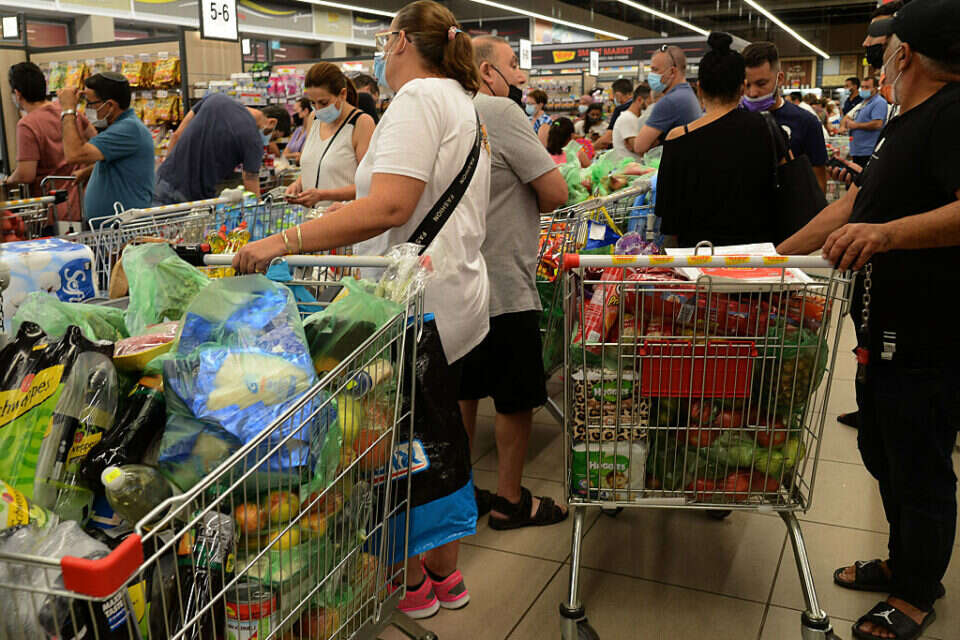Rosh Hashanah is approaching and with it the increase in demand for various products including foods associated with it.
Before the holiday, the Ministry of Agriculture publishes the consumption data of the popular foods
fish
The Ministry of Agriculture publishes data on the fish industry ahead of Rosh Hashanah and the Tishrei holidays: in an average week, Israelis consume about 345 grams of fish, with about 25% of this amount being fresh fish, while during the holiday shopping week, consumption rises to about 563 grams per capita.
Towards Rosh Hashanah during the holiday shopping week (7 days before the eve of the holiday) the Ministry of Agriculture expects an increase of about 71% in the amount of consumption of all fish compared to an average week during the year.
The consumption of fresh fish during the holiday shopping week constitutes about 29% of the total consumption of fish in general (fresh and frozen), compared to about 25% on average over the whole year.
The leading fish in sales in the marketing chains during the holiday period are tilapia and salmon with about 36% of total fish sales for each of them, followed by bream in third place with about 5% and in fourth place carp with about 4% of total fish consumption during the holiday shopping week.
In an average week, Israelis need about 345 grams of fish, photo: Herzi Shapira
In 2020, about 166,400 tons of fish were consumed (in whole fish terms), most of the fish consumed in Israel is imported (about 90%), 150,900 tons from imports (mostly frozen fish) and about 15,500 tons from local production.
The local production of fish is divided into three sources: the fish ponds about 11,100 tons, aquaculture about 3,500 tons and fishing in the Mediterranean Sea and the Sea of Galilee about 900 tons.
The Ministry of Agriculture and Rural Development encourages the consumer public to consume fresh healthy Israeli fish during the holiday period.
meat
The data from the Ministry of Agriculture shows that the average supply per capita in 2021 was about 19.6 kg of beef (fresh and frozen). In 2021, the meat supply is estimated at about 182 thousand tons of meat. The fresh meat consumed in Israel can be divided into three main categories: Fresh meat slaughtered in Israel (40%), imported chilled meat (14%) and imported frozen meat (46%), the latter two arrive in Israel after being slaughtered abroad.
The average supply per capita in 2021 was close to 20 kg of meat, photo: Gideon Markowitz
During the shopping week leading up to Rosh Hashanah, an increase in demand and consumption of approximately 84% is observed compared to the average amount of meat sold in the marketing chains during the rest of the year.
chicken
The local consumption of chicken is the highest in the world and stands at about 64.9 kg per person per year, while the consumption in the oecd countries is estimated at about 31.8 kg per person per year, in the USA which ranks second at about 50.8 kg per person per year.
The global average is estimated at only 14.9 kg per capita. Today, there are approximately 500 breeders operating in the local chicken industry (broiler). In the run-up to Rosh Hashanah, during the shopping week for the holiday, consumption increases by approximately 57% (according to an analysis of sales data in marketing chains in 2021).
pomegranates
According to the data of the Ministry of Agriculture, it is estimated that the pomegranate harvest in the 2023/2022 season will be about 45,000 tons, similar to the previous season.
For many years, the pomegranate industry concentrated mainly on marketing whole pomegranates during the Tishrei holidays, and its scope was limited to about 3,500 dunams.
The average Israeli consumes about 5.4 kg of pomegranates per person per year, photo: Oren Ben Hakon
You can see a significant increase in the sale of pomegranates in the marketing chains in the week before the eve of the holiday.
The amount of pomegranates sold this week constitutes about 15% of the amount sold during the entire year.
The average Israeli consumes about 5.4 kg of pomegranates per person per year, including pomegranate products (eg: pomegranate juice).
apples
According to the data of the Ministry of Agriculture, there are about 25,000 dunams of apple orchards bearing fruit in Israel.
The crop of the year 2021/20 was about 105 thousand tons, and the crop estimate for the 2022 season is about 110 thousand tons.
The average Israeli eats about 14.9 kg of apples a year. During the week of holiday shopping, about 76% more apples are consumed than during an average week throughout the year. The main varieties are: "Grannysmith" (green), "Zhavov" (yellow), "String" ( red), "Pink Crispy" (pink-green) and "Gala" (red).
The import of apples to Israel in 2020 was about 39.8 thousand tons, photo: Oren Ben Hakon
The annual global production of apples for the 2021/22 season is estimated at 81.6 million tons.
The main countries that grow apples are: China (45 million tons per year), Europe (11.9 million tons per year), the USA (4.3 million tons per year) and Turkey (4.3 million tons per year). In general, apples love the cold, so Israel is on the edge of the regions The vast majority, about 90%, of the apples in Israel are grown in the northern region, in the Galilee and Golan mountains at altitudes of at least 600 meters.
Israel does not export apples, and even the export of apples from the Druze communities in the Golan to Syria has been stopped due to the security situation in Syria.
The import of apples to Israel in 2020 was about 39.8 thousand tons mainly from the USA, Italy, France and Spain.
wine
The analysis of the Division for Research, Strategy and Economics shows that the average Israeli consumes about 5.6 liters of wine per year.
This is a low figure compared to the countries of the world, in particular the countries of Europe and the USA. For comparison, in France the consumption of wine is about 46 liters per year. In Portugal, the world leader in wine consumption per capita, the figure is about 51 liters (!!). According to data Stornext, about 31.6 million liters of wine were sold in Israel in 2020, an increase of about 36% in wine sales in Israel between the years 2010 and 2020. The average price per liter of wine in Israel was NIS 36.6 in 2020. The Israeli consumer has no clear preference between wine red to white, with red wine accounting for a little over 50% of total sales in Israel. However, over the years, an upward trend in the consumption of white wine in Israel can be noticed. In addition, there has been an upward trend in the consumption of sparkling wines, which is in line with the global trend.
In Israel, about 50 thousand tons of wine grapes are grown per year on an area of about 63 thousand dunams.
Israeli wine production is about 40 million bottles of wine per year (about 30 million liters).
In 70% of the vineyards in Israel, red grape varieties are planted, with the most popular being Cabernet Sauvignon, Carignan and Merlot.
Israeli wine is not only beautiful in our eyes, but also in the eyes of others: in the last decade, the export of Israeli wine to the countries of the world has increased and, as of 2020, amounted to approximately NIS 170 million.
The USA is the largest export destination in this industry, about 60% of all exported wine goes to the USA, according to estimates it is about 3 million liters of wine per year.
Among others, Israel exports wine to France (10%), Great Britain (5%), Canada (5%) and Germany (3%).
were we wrong
We will fix it!
If you found an error in the article, we would appreciate it if you shared it with us









